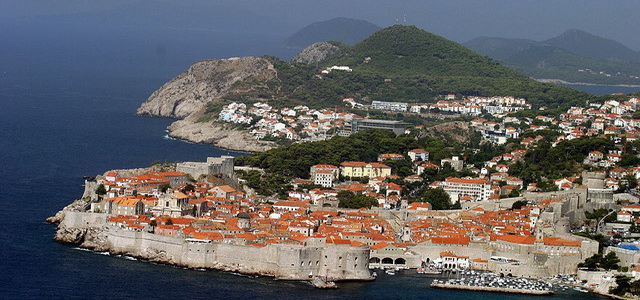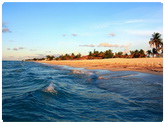| Quick Facts: | Adriatic Sea |
|---|---|
| Countries: | Italy Slovenia Croatia Montenegro Bosnia Herzegovina Albania |
| Major Rivers: | Po Adige Drin Neretva |
| Max. depth: | 1.220 meters (4002.62 ft) |
| Temperature: | Winter: 8-13°C Summer: 22-25°C |
| Salinity: | 38 to 30% |
| Area: | 160.000 km² (60.000 mi²) |
The Adriatic Sea is an arm of the Mediterranean Sea, located between the Italian and Balkan peninsulas.
It extends northwest to southeast for a length of about 480 miles (772 km) from the gulfs of Trieste and Venice to the Strait of Otranto. Adriatic Sea is bordered by Italy on the west and north and by Slovenia, Croatia, Montenegro, Bosnia and Herzegovina and Albania on the east.
The Adriatic is a shallow sea, reaching a maximum depth of around 1,220 meters (4,000 feet). Its width varies from 60 to 140 miles (95 to 225 km), and on average it is 100 miles in width. The Adriatic was named after Adria, a once flourishing port located southwest of Venice.
Economic importance of the Adriatic
The Adriatic’s western shore is mostly lowland created from erosion of the Apennine Mountain range. This coast is generally low and straight, except between Trieste and Ravenna, where it is interrupted by marshes and lagoons.
Because this region has very few major rivers, and the minor ones are short and flow on a course perpendicular to the coast, it has few ports capable of protecting shipping in bad weather. Bari and Brindisi are the most prominent cities close to the Straits of Otranto in the south, while Ancona is the only major port in the center of the Italian coast. Smaller ports are located at Trieste and Venice.
On the opposite, the eastern shore is high and rocky, fringed with islands and inlets. On the eastern shore, the most important ports are Rijeka, Split, and Dubrovnik in Croatia; and Durrës and Vlonë in Albania. Fishing is an important activity on the eastern coast, as lobsters and sardines are plentiful.
Economic role in history
With the rise of the republic of Venice during the Middle Ages, the Adriatic became the chief trade route between central Europe and the Orient. It declined in importance with the fall of Constantinople in 1453 and even further with the opening of the Suez Canal in 1869.
Tourism on the Adriatic Sea
Tourism is an important activity on both sides of the Adriatic coast. Venice is undoubtedly the most visited destination on the Adriatic, but towns such as Rimini also play an important touristic role.
On the eastern shore, the mild climate, blue waters, and striking landscape have made of the Croatian coast of the Adriatic one of the playgrounds of Europe. Dubrovnik, Split or Pula are just three of the more well known Croatian destinations on the Adriatic.
Islands in the Adriatic Sea
There are 1246 islands in the Adriatic Sea, and out of these 69 are inhabited. Most of these islands are located on the Croatian coast. Hvar is the longest island of these, being 68 km long (42 miles).
The island of Krk is a popular tourist destination, but is also home to about 18,000 people. Mljet is another popular tourist island, located near Dubrovnik.
Rivers in the Adriatic
There aren’t many important rivers feeding the Adriatic, and most of the rivers that feed it are from Italy. Italy’s two biggest rivers, the Po and the Adige both discharge in the Adriatic, the Po forming a large delta before doing so.
On the eastern coast, the most important river flowing into the Adriatic is the Neretva River.





